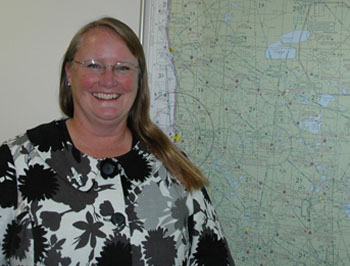By Bob Filipczak

Kathy Vesely, aviation planning director, has worked at MnDOT for 33 years. Photo by Bob Filipczak |
Kathy Vesely, MnDOT’s aviation planning director, is currently in the middle of developing the State Aviation System Plan on an accelerated time schedule. Usually, the transportation plan for Aeronautics takes two years to develop; Vesley is working hard to get this one done in 18 months.
The aviation plan Vesely is working on needs to take into consideration several elements that other planners don’t encounter. Aeronautics, she said, “is the least understood office in MnDOT,” so part of her job involves educating and marketing one of the best aviation systems in the country—both internally and externally.
Vesely has been with MnDOT for 33 years, working in several different offices. When she and her husband started flying for fun, she moved to Aeronautics so she could align her love of flying with her work.
What’s different about Aeronautics planning?
Almost everything is different. First off, we have our own unique standards and requirements from the Federal Aviation Administration; and they delegate a lot less than the Federal Highway Administration. For example, the environmental review process for most of MnDOT is delegated to the state level, but not with the FAA. We work very closely with the FAA.
Also, our priorities are different. For example, our first priority is obstruction clearance. That means keeping trees, antennas and other things away from runways. If we have to cut down a lot of trees, that requires a separate environmental impact statement, so we need to talk to the FAA.
Wind turbines are a new challenge. The turbulence created by wind turbines affects our ability to use radar. On radar, a wind turbine can look just like a huge storm.
Smokestacks and the plumes they create are another challenge for planning. Energy companies like to have airports close to their facilities so they can fly in technicians and parts at a moment’s notice. The plumes they create can turn an easy landing into one that has to come in on instruments if the wind is from the wrong direction. Anyone who has seen the plume coming from Monticello’s energy facility can imagine the flying challenges that presents.
Even our pavement considerations are different. We need to keep the ice off the runways, but we can’t use salt or sand. Most of the aircraft we serve are made of aluminum and some of the parts aren’t painted, so the corrosion created by salt would be unacceptable.
How many airports are included in the transportation plan?
We have 135 airports in Minnesota that are included in our planning. We are always balancing safety with the other needs of the public. Safety zoning is a very complicated process where we are looking for ways to avoid land use problems on the ground, while protecting life and property for both passengers in the air and people on the ground. Sometimes those priorities conflict with property-rights folks and developers who want to build close to the airport. Those negotiations can get heated.
My personal challenge in this job is to bring some of my own excitement about aviation to my friends on the highway side so they don’t forget about us when they are doing a project near an airport.
What makes Minnesota a top aviation center?
Minnesota is really good in terms of aviation compared to other states. They don’t have the same caliber of pavement. They don’t have the arrival departure systems. Part of why we are so good is the weather challenges we must overcome. We have one of the top 10 systems in the country.
Minnesota has a lot of Fortune 500 companies that rely on general aviation to serve their business needs. That means flying in customers and executives, as well as parts and repair technicians. All of those things rely on air transportation.
What is general aviation?
That’s all the aviation that goes on outside of the airline business. We think of the airlines as public transportation, while general aviation is more like all the cars on the road. It’s important to realize that most of the air traffic in Minnesota’s airspace is from general aviation.
How does funding factor in?
Unlike most of MnDOT, we don’t have constitutionally dedicated fund for Aeronautics. From time to time, our funds get re-appropriated by the Legislature, so that’s a challenge. We’ve got some allies in the Legislature who help us out by including more airport projects into bonding bills. That helps even things out.
Do you or a co-worker have an interesting job to share with readers? Click here to send us your ideas, and we’ll contact you for more information.
Recent employee profiles:
|



